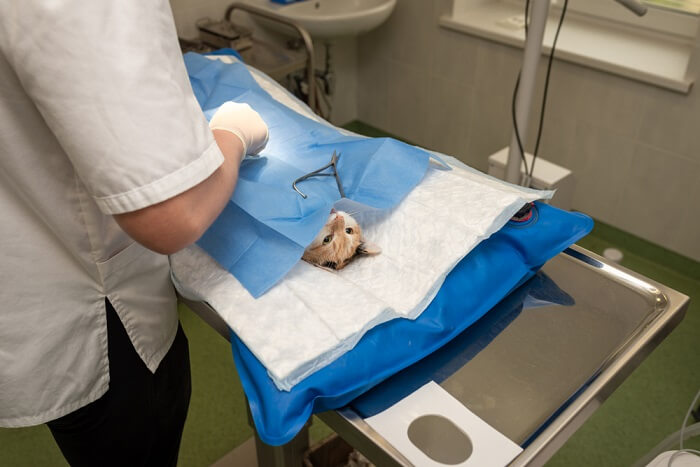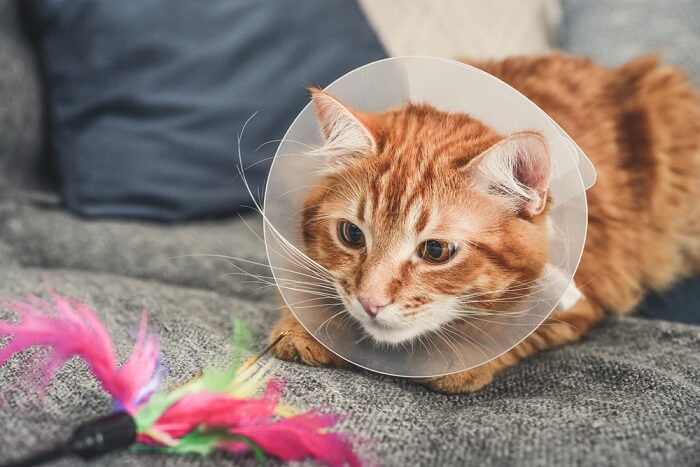
After a cat undergoes surgery of any kind, strict rest is an important part of their recovery process. In order for any wound to heal, the area must be stopped from moving, as far as possible. Movement causes stress and tension across a wound, delaying healing.
In particular, cats should be stopped from jumping, as this type of sudden movement is likely to place significant stress on wound sites. This article explains different aspects of caring for your cat after surgery.
What Sort of Surgeries Are Cats Most Sensitive About?

Many operations involve the cat’s skin being cut with a scalpel blade, then being closed with sutures at the end of the surgical procedure. Common examples include spaying of female cats, any abdominal surgeries, removal of small tumors, surgeries to the ears and tail, and orthopedic procedures.
Other operations may include an incision, but sutures may not be used to close the wound at the incision site: the neutering of male cats is the best example, where the testicles are removed via an incision, but no stiches are placed afterwards.
In general, the larger the wound, and the deeper the wound, the bigger the impact on the cat. But in all cases, to optimize the healing process during the post-surgery period, it’s important that the cat is rested, and stopped from jumping.
Are Cats in Pain After Surgery?

During the anesthetic, a cat is unconscious, so they cannot feel any pain. However when they recover from anesthesia, they may feel pain at operation sites, so most veterinarians prescribe pain medications, given by injection at the time, and also sometimes orally afterwards at home as part of the aftercare, depending on the procedure.
The aim is to ensure that cats experience minimal discomfort in a couple of days after the cat’s surgery in particular, as they recover from the operation. Pain meds can have possible side effects, so you should discuss this possibility with your veterinarian so that you know what to look out for.
Does It Matter if Cats Lick Their Wounds After Surgery?

Cats have a natural instinct to lick wounds: in nature, this is an important part of cleaning injured areas. However, a cat’s tongue is rough, and excessive licking damages the skin and causes redness and soreness, delaying healing. For this reason, if a cat is likely to lick an incision site, your dvm veterinarian may recommend methods to stop them from licking the wound.
An Elizabethan collar (an e-collar, also known as the “cone of shame”) is the best known answer, but sometimes inflatable collars are used, or dressings may be applied to certain areas of the body (limbs, tail etc).
It’s important that the e-collar is kept in place at all times, unless you can directly observe your cat. This may only need to be kept on for the first couple of days, and you need to pay attention to them during this period: cats can get themselves tangled up in e-collars if left unobserved.
Can My Cat Eat Normally After Surgery?

To help your cat hurt the least possible, you should make sure that you offer your cat her food on the ground, rather than higher up on a stool or counter.
Your veterinarian will advise you on what to feed on the first day after surgery, but usually, normal cat food can be offered soon after returning home. Sometimes a special recovery diet may be recommended, or you may be asked to offer half the normal amount of food during the cat’s recovery period.
You should make sure that you offer your cat her food on the ground, rather than higher up on a stool or counter, so that she does not need to jump or climb to get to her food.
Some cats suffer the loss of appetite after operations, so do not be surprised if they are not as hungry as usual.
Can My Cat Use the Litter Box Normally After Surgery?

It’s important that cats continue to pass urine and feces after surgery, so you should ensure that you provide their usual litter box, and again, have this in a place where they do not need to climb to reach it.
You may wish to use a different cat litter substrate, such as shredded paper, so that pieces of gritty litter do not contaminate the cat’s incision site.
If you are keeping a cat indoors that is usually allowed to go outdoors, a litter box is also important.
Can I Let My Cat Move Around the House Normally?

Even though cats love cat trees, they shouldn’t be allowed to have access to them during their recovery time as it’s important to keep your cat’s movements to a minimum.
When you bring your cat home, it’s best to confine them to some degree. Some pet owners use a small room as a base for their cat, with a comfy bed on the ground, so that they are unable to run around or jump.
Some people may even confine their cat to a kennel, or a carrier cage, but the need for this depends on your cat, and on the procedure they are recovering from.
Can I Let My Cat Use Her Cat Tree as Normal?

Cats love cat trees, but they should not be allowed to have access to them during their recovery time, as they may climb, stretch and jump when using the tree, and this is not a good idea.
Do I Need To Keep My Cat Indoors After Surgery?

It’s important that you keep your cat’s movements to a minimum, and this means restricting physical activity. For this reason, cats should be kept indoors if possible for anything up to ten days after the procedure. For feral cats, you may wish to confine them to a shed outside, rather than your home. Remember to leave them a litter box if you do this.
Conclusion

After any surgery, it’s important that the healing process proceeds as well as possible, so cat owners need to make sure that they restrict their cat’s movements, as well as preventing them from interfering with the incision site of an operation.
Frequently Asked Questions
My cat was meowing the next day after her operation. Was she in pain?
Not necessarily. Cats meow for many reasons, including to get attention from their owners, to go outside, or for food.
Can I give my cat cuddles as normal after her spaying operation?
As long as your cuddles do not interfere with the operation site at all, it's good to give your cat cuddles. She will find it reassuring and comforting to have cuddles from you. This may even help to prevent her from moving around as much or jumping up for attention, and this is a good thing.
How often should I check my cat's wound?
It's important, generally, to pay attention to a cat's operation site for the ten days after a procedure. You should look at it first thing in the morning, last thing at night, and several times during the day. As long as it appears to be clean, dry, and comfortable, and as long as you are managing to stop your cat from running and jumping, and you are making sure that the wound is not being licked, there is not usually too much to worry about.







